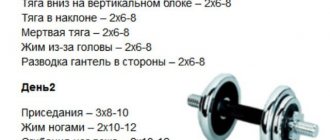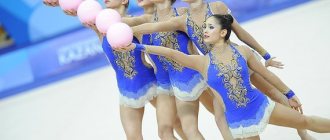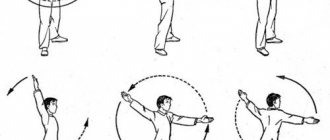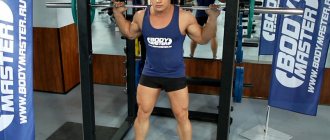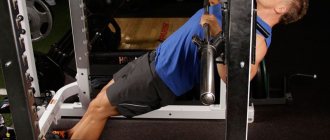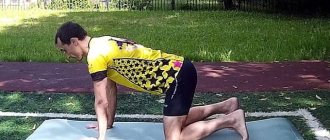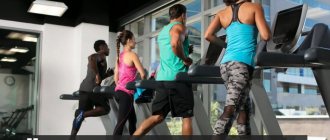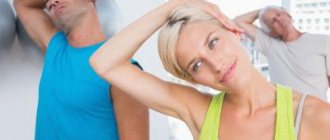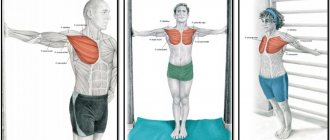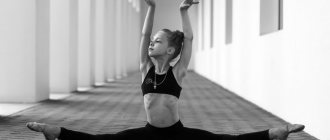© luckybusiness — stock.adobe.com
Share:
What you need
- Dumbbells
- Barbell
- Horizontal bar
- Exercise equipment
- Fitball
We often hear from various fitness bloggers that without doing basic exercises there can be no growth. What confirms their effectiveness? In this article we will try to answer this question, and also figure out how to do basic basic exercises and how to implement them into your training process.
The best basic exercises for different muscles
There are both basic and isolation exercises for each muscle group. It is especially important to perform basic exercises for beginner athletes. This way, you will quickly build a certain strength base, from which it will later be easier for you to build muscle, improve the functionality of your body, or increase record weights in strength movements. But it is not recommended for experienced athletes to abandon the base; in any case, it should make up the majority of your program.
It is worth noting that not all athletes will benefit from regular exercise. Many of them (such as deadlifts and squats) involve a strong axial load on the spine. It is not recommended to perform them for herniated discs and protrusions, especially in the lumbar region. In addition, performing these exercises with large working weights is quite a traumatic activity, and the slightest deviation from the correct technique can not only aggravate existing health problems, but also cause new ones to arise.
For beginners who train without a trainer, it is also better not to include deadlifts and squats with a barbell in their program, since learning the technique from scratch on your own will be quite difficult. It is better to first develop skills in working with iron using simpler basic exercises, and only then move on to complex ones. Or immediately start working with a trainer.
Below we provide a list of basic exercises for each muscle group. They are suitable for both men and women, the most important thing about them is the correct technique.
Differences between basic exercises and isolation exercises
As in any sport, bodybuilding training has certain features. Each athlete sets certain goals before training, and, depending on them, creates his own program. And to make the exercises even more effective, many athletes actively use those that are considered basic in their training. There are four basic principles that allow us to call the exercise basic:
- With the exception of push-ups and pull-ups, all basic exercises are performed with a barbell
- Impact falls on large muscle groups
- When performing the exercise, at least two joints are set in motion
- The starting position in the exercise is the most convenient for developing greater effort from an anatomical point of view
Basic leg exercises
Let's first talk about basic leg exercises. After all, many ignore this muscle group, but in vain.
Squats
Barbell squats are one of the fundamental exercises in many sports. In this movement, almost all muscle groups of your body work in one way or another. The main dynamic load falls on the quadriceps, hamstrings, spinal extensors, gluteal muscles and hip adductors. When working with serious weight, a significant static load falls on the abdominal muscles, shoulders and trapezius muscles.
The main thing in this exercise is to monitor your breathing (exhale strictly when lifting) and keep your back straight throughout the entire movement - this way you will protect yourself from injury.
© Vitaly Sova — stock.adobe.com
A clear position of the head helps stabilize the movement - the gaze should be directed strictly in front of you or slightly upward, this will make it psychologically easier for you to get up from a lower position.
Don't forget about the position of your feet - in general, they should be spaced slightly wider than your shoulders, with your toes pointing to the sides. When rising from a squat, never bring your knees together.
This also includes squats in Smith and hack machine. These movements are a little simpler in terms of technique. The general principle is the same, but the position of the body and the projectile is more fixed, which is why fewer stabilizer muscles are involved in the work.
© mountaira — stock.adobe.com
Leg press
The platform leg press cannot fully replace heavy squats with a barbell, but the load on the legs is no less: the front, back and inner thighs and gluteal muscles work. Perfect for beginners for whom the squat technique will be too difficult at the initial stage.
The most important thing in this exercise is not to overdo it with the working weight. This will make it more difficult for you to control the correct position of your knees. If you bring them inside the trajectory of movement, you risk injury to the ligaments.
It is also important to work in a comfortable amplitude. Do not try to lower the platform as low as possible. The geometry of most exercise machines is designed in such a way that at the lowest point your spine will be rounded in the tailbone area. This is an extremely traumatic position. At the top point, you don’t need to straighten your knees all the way, leave them slightly bent.
Lunges
You can perform lunges with your own weight, with a barbell or dumbbells. In any variation, you will use all areas of the leg muscles. Depending on the width of the step, the direction of movement and the position of the foot, you can slightly emphasize the load on one or another area: with a shorter step, the emphasis falls on the quadriceps, with a wide one, on the hamstrings.
If you perform a step in such a way that at the bottom point the angle between the shin and the thigh of both legs is 90 degrees, the load is equally distributed on the front and back surfaces of the thigh.
Sumo deadlift
This is a variation of the classic deadlift, in which the emphasis shifts to the legs (adductors, quadriceps and hamstrings) and works the back to a lesser extent. This is achieved through wider stance of the legs. The range of motion in a sumo stance is a little shorter, but this does not eliminate the powerful static tension in the abdominal muscles, back, trapezius and arms.
The correct technique for performing a sumo deadlift involves a deep squat in the starting position and maintaining a straight back throughout the entire exercise. This way you minimize the risk of back injury or umbilical hernia.
Athletes who are not involved in powerlifting should avoid using an underhand grip, as it can also lead to spinal injury. Use a regular overhand grip; you can attach straps if the weight is too heavy.
Romanian deadlift
It is often mistakenly called a deadlift, although in fact a deadlift is a regular classic deadlift. In the Romanian version, the legs remain slightly bent throughout the entire approach; the work is mainly carried out by the extensors of the spine and biceps of the thigh. That is why this exercise can be considered a basic one for the back. It’s also a good idea to include the gluteal and other additional stabilizers (trapezius, calf, etc.).
There is no need to perform this movement with fully straightened legs, as this can cause injury. The angle of the knees should not change throughout the entire approach. The bend should be done to a comfortable point, stretching is different for everyone, and should not be done through pain. It is also important not to hunch your back; if you can’t do this, reduce the working weight.
Another version of this exercise is with dumbbells, the technique here is identical, but the emphasis shifts more to the gluteal muscles.
Virtuosity
In order for a ballet jump to be light and airy, creating a feeling of weightlessness and flight, students must work long and hard for years. Muscle strength, good stretching, flexibility and joint mobility are crucial.
Compared to the soft legs of ordinary people, the ballerina's calf muscles have a steel hardness.
When a dancer runs up before jumping, he develops a high horizontal speed - 8 m/s, and a vertical speed - 4.6 m/s. If we think in scientific terms, the acceleration of artists when jumping in ballet is 2 g, which is comparable to the take-off run of an airplane.
Just as a book is made of words, a house is made of bricks, any ballet is made of movements. Strict, once and for all established positions of arms and legs, poses, jumps, rotations, connecting movements are the basis of classical dance. By combining these movements and arranging them in a certain order, the choreographer creates a choreographic pattern for the ballet. The beauty and power of movements depend on whether they accurately express the character of the music, and on the meaning that the director - choreographer and performer - ballet dancer puts into them. And it turns out that the same movement can look different, it can be good and evil, brave and cowardly, beautiful and ugly, and this sometimes depends on the tilt of the head, sometimes on the position of the arms and body, on the strength and expressiveness of the jump, from the smoothness and speed of rotation. That’s why ballet performances are so different from each other.
There are basic movements and concepts in ballet that every lover of this art should know! The main 4 poses in ballet are called Arabesque, Ecarte, Alaskan and Attitude. These are poses in which the performer balances on one leg while holding the other in the air.
ALASGON, ARABESQUE, ATTITUDE, EKARTE. The main poses, the “pillars” on which classical ballet rests. In all these poses, the performer stands on one leg and the other is raised high: to the side (alasgon), back (arabesque), back with a bent knee (attitude), diagonally forward or backward (ecarte).
ASSEMBLY. A jump during which one leg opens to the side, forward or backward, and at the end of the jump is pulled towards the other leg.
Adagio - A dance of two or more ballet characters, aimed at revealing the emotional state.
Pa (French pas - step) is a separate expressive movement performed in accordance with the rules of classical dance.
Glide path is a special movement, the main purpose of which is preparation before the jump.
Glissé (from glisser - to slide) is a step in which the toe slides along the floor from position V to position IV. Used as an approach to pirouettes, to jumps. Glisse r. in arabesque, repeated several times, is one of the most beautiful and expressive movements of classical dance.
Grand batman (from the French grands battements) - a leg throw to the maximum height.
Plie (plié - fold, gently bend) - demi plié - a small squat.
BURN. Jump from one leg to the other. Grand jetés are performed as a jump over an imaginary obstacle in all the main ballet poses - arabesque, attitude, alasgone.
CABRIOLE. A jump during which one leg kicks the other. The legs are strongly extended. This jump is performed in all directions: forward, sideways, backwards.
Balloon (from the French ballon, from balle - ball) - the dancer’s ability to maintain the pose and position taken on the ground while jumping (in the air) - the dancer seems to freeze in the air.
Batri (from the French batteries - to beat) - jumping movements decorated with skids, i.e. kicking one foot against the other in the air. During the impact, the legs are crossed in the V position (before the impact and after it, the legs are slightly spread apart).
Entre (from the French entree - introduction, entrance to the stage) - in ballet, the appearance of one or more performers on stage. Introductory movement to pas de deux, pas de trois.
PA DE DEUX. The main dance scene in a ballet or one of the acts of a ballet. The pas de deux reveals the relationships between the characters and shows the dancing skills of the performers. The pas de deux consists of an adagio, a dancer's variation and a ballerina's variation and coda - short, technically difficult dance pieces between the dancer and the ballerina.
Coda (from French Coda) - fast, final part of the dance, following the variation
FIFTH POSITION. Basic leg position of classical dance. The legs are turned one hundred and eighty degrees. The heel of the right foot is pressed tightly to the toe of the left, and the heel of the left foot is pressed tightly to the toe of the right. The dance most often begins from this position, and this position most often ends.
PIROUETTE. Rotation around its axis on half toes or toes of one foot. Pirouettes are small when, during rotation, one leg is tightly pressed to the other in front or behind. Large pirouettes are performed in all basic poses.
Arondi (from the French arrondie - rounded) - rounded position of the hand.
SOTE. A jump during which the legs are strongly extended in the first, second or fifth positions.
TOURS. Rotation around its axis during a jump. Tours are made with one and two revolutions. A round with two turns is an element of male dance.
Brize (from the French brisé - to break; means a light, gusty sea wind) - a small jump, moving forward or backward behind the leg. The jump ends in V position. Variation: brise dessus (forward) - dessous (backward).
CHAZHMAN DE PIED. A jump during which the legs are in fifth position and change places.
Ronde de Jambe - literally translated from French - circle with your foot. In fact, in this movement the leg describes a semicircle.
Shazhman de Pie is a special jump from the fifth position, in which the legs change places.
Fouette is the ballerina’s most famous movement, or more precisely, her spin on the toes of one foot like a top. The ballerina rotates around her axis on the toes of one foot. After each turn she opens the other one to the side. Fouette is usually performed at a very fast tempo, sixteen or thirty-two times in a row.
Entrechat (entrechat - Italian intrecciato - braided, also defined for the type of jump as crossed) - a vertical jump with two legs, during which the legs are slightly separated in the air and connected in the V position again, without hitting each other, since they are in a reversible position from the hip.
VARIATION. Solo dance, dance monologue. A short dance for one or more dancers, usually more technical. There are variations for men and women, terre a terre and jumping. The first are built on small, technically complex movements, the second - on large jumping movements.
A la zgonde (from the French a la seconde) is a classical dance pose when the leg is raised to the second position to the side by 90° or higher.
Elevation (from the French elevation - elevation, elevation) - in classical dance means a high jump.
SUPPORT. An essential element of classical dance. During the dance, the dancer helps the ballerina, supports her, and lifts her up.
Eversion is the opening of the legs at the hip and ankle joints.
PACK. A ballerina costume consisting of many short starched tulle skirts. These fluffy and light skirts make the tutu airy and weightless.
POINTE SHOES. One of the main elements of female dance in classical ballet is dancing on the tips of outstretched fingers. For this you need ballet shoes with a hard toe.
LESSON. Ballet dancers never stop learning. Every day they come to the ballet class for a lesson. It lasts at least an hour. The lesson is divided into two halves: the smaller one - exercise (exercise) at the barre and the larger one - exercise in the middle of the hall. During the lesson, all the movements that a ballet dancer needs in dancing are improved and practiced.
CHOREOGRAPHER. A person who composes, or, as they say, choreographs a ballet. Sometimes a choreographer, or ballerina, is the name given to the performers of male parts in ballet. It is not right. A man in ballet is called a dancer.
Divertissement (from the French divertiss-ment - amusement, entertainment) - 1) Inserted (ballet or vocal) numbers performed between acts of a performance or at the end of it, often forming a single entertaining performance not related to the plot of the main one; 2) A structural form within a ballet performance, which is a suite of dance numbers (both concert solo and ensembles, and plot miniatures).
LIBRETTO. Literary script of the ballet, its content.
Corps de ballet (from the French corps de ballet, from corps - personnel and ballet - ballet) is a group of dancers performing group, mass dances and scenes. The corps de ballet can perform both independently and in mass dances.
Premier (from the French premier - first) - a ballet soloist who performs the main roles in the performances of a ballet troupe; dancer of the highest category. The first premier dancer in the history of ballet was Pierre Beauchamp, a soloist of the ballet of the Royal Academy of Music, created in 1669 by King Louis XIV (danced from 1673 to 1687).
Having studied these concepts, you will always understand what various experts are talking about during the intermission of another beautiful ballet.
Just as a book is made of words, a house is made of bricks, any ballet is made of movements. Strict, once and for all established positions of arms and legs, poses, jumps, rotations, connecting movements are the basis of classical dance. By combining these movements and arranging them in a certain order, the choreographer creates a choreographic pattern for the ballet. The beauty and power of movements depend on whether they accurately express the character of the music, and on the meaning that the director - choreographer and performer - ballet dancer puts into them. And it turns out that the same movement can look different, it can be good and evil, brave and cowardly, beautiful and ugly, and this sometimes depends on the tilt of the head, sometimes on the position of the arms and body, on the strength and expressiveness of the jump, from the smoothness and speed of rotation. That’s why ballet performances are so different from each other.
ALASGON, ARABESQUE, ATTITUDE, EKARTE. The main poses, the “pillars” on which classical ballet rests. In all these poses, the performer stands on one leg and the other is raised high: to the side (alasgon), back (arabesque), back with a bent knee (attitude), diagonally forward or backward (ecarte).
ADAGIO. A dance of two or more ballet characters in which they reveal their inner state. ASSEMBLY. A jump during which one leg opens to the side, forward or backward, and at the end of the jump is pulled towards the other leg.
CHOREOGRAPHER. A person who composes, or, as they say, choreographs a ballet. Sometimes a choreographer, or ballerina, is the name given to the performers of male parts in ballet. It is not right. A man in ballet is called a dancer.
VARIATION. Solo dance, dance monologue.
GLISH SAD. Sliding lateral movement. Usually it connects one movement to another, serves as a preparation, a run-up for a jump.
BURN. Jump from one leg to the other. Grand jetés are performed as a jump over an imaginary obstacle in all the main ballet poses - arabesque, attitude, alasgone.
CABRIOLE. A jump during which one leg kicks the other. The legs are strongly extended. This jump is performed in all directions: forward, sideways, backwards.
LIBRETTO. Literary script of the ballet, its content.
PA DE DEUX. The main dance scene in a ballet or one of the acts of a ballet. The pas de deux reveals the relationships between the characters and shows the dancing skills of the performers. The pas de deux consists of an adagio, a dancer's variation and a ballerina's variation and coda - short, technically complex dance pieces between the dancer and the ballerina.
PACK. A ballerina costume consisting of many short starched tulle skirts. These fluffy and light skirts make the tutu airy and weightless.
PIROUETTE. Rotation around its axis on half toes or toes of one foot. Pirouettes are small when, during rotation, one leg is tightly pressed to the other in front or behind. Large pirouettes are performed in all basic poses.
SUPPORT. An essential element of classical dance. During the dance, the dancer helps the ballerina, supports her, and lifts her up.
POINTE SHOES. One of the main elements of female dance in classical ballet is dancing on the tips of outstretched fingers. For this you need ballet shoes with a hard toe.
FIFTH POSITION. Basic leg position of classical dance. The legs are turned one hundred and eighty degrees. The heel of the right foot is pressed tightly to the toe of the left, and the heel of the left foot is pressed tightly to the toe of the right. The dance most often begins from this position, and this position most often ends.
ROND DE JAMBE. In French it means circle with your feet. In fact, half of the circle is described by the leg on the floor and in the air, during a jump and squat.
SOTE. A jump during which the legs are strongly extended in the first, second or fifth positions.
TOURS. Rotation around its axis during a jump. Tours are made with one and two revolutions. A round with two turns is an element of male dance.
LESSON. Ballet dancers never stop learning. Every day they come to the ballet class for a lesson. It lasts at least an hour. The lesson is divided into two halves: the smaller one – exercise (exercise) at the barre and the larger one – exercise in the middle of the hall. During the lesson, all the movements that a ballet dancer needs in dancing are improved and practiced. CHAZHMAN DE PIED. A jump during which the legs are in fifth position and change places.
FOUETTE. The ballerina rotates around her axis on the toes of one foot. After each turn she opens the other one to the side. Fouette is usually performed at a very fast tempo, sixteen or thirty-two times in a row.
Terminology in ballet
This page is a glossary.
French school
Looks like Russian. Movements: les fouettés en dedans et en dehors, les fouettés sautés, les fouettés sur pointes ou demi-pointes
:
A pique is made on the right leg, the left leg is raised forward, a tour on the toe (sur la pointe) or half-toe (demi-pointe) occurs and the left leg remains extended in the air. ends in en arabesque sur pointe (ou demi-pointe).
American school
Fouette en tournant at 45° En dehors
. If in the Russian school during a tour the right leg touches the back of the calf of the supporting left leg, then moves on to touch the front of the calf of the left leg (like a petit battement), then here the working leg makes a demi rond at 45°, which gives the movement additional force, but it’s dangerous “ releasing the hip,” which can cause the ballerina to go off axis, and Fouetté results in moving forward or to the side.
- Grand Fouette
.
It contains something from both the French and Italian schools (approx. Vaganova)
. - les fouettés en dehors
.
Pose croiseé back with the left leg. Coupé on the left foot on the half-toes, hands in the second position, lower on the left leg to the demi-plié, the left hand goes down to the 1st position. Bringing the half-bent right leg forward 90° (modern 120°), rise on the left half toes, quickly sweeping the Grand Rond de Jambe
back with the right leg and finishing it on the left leg on the
demi-plié in III arabesque (in the en face position)
. The hands do the following Port de bras: The left one rises to the third position and passes to the II, while the right goes to the III position and passes through the first to the III arabesque while lowering the left leg to the plié. - les fouettés en dedans et en dedans
- The movement is done according to the same principle. - . Stand in a forward croiseé position (left leg in front), lower yourself into a demi-plié position on your left leg, jump onto your toes and throw your right leg into the second position (alaseconde) at 90° (120°) - Grand battement jeté. Turning, swing your right leg across the floor through a passé par terre (passing motion). The supporting leg turns on its toes (turn to en dedans), keeping the right leg at the same height. Finish the movement with 3 arabesques on plié mli on arabesque.
- Grand Fouette en tournant en dedans (Italian fouette)
. It is performed on the fingers according to the same principle. Only it starts not with plié, but with sur le cou de pied, but is swayed in the attitudé position on pointe shoes, croisé, the right hand in the third position, and the left in the first. - Grand Fouetté en tournant sauté
is performed according to the principle of
Grand Fouetté en tournant en dedans
, only the left leg leaves the floor with a jump, the turn is also made in the air, with the left leg jumping.
Basic exercises for the back
Now let's talk about how to achieve a powerful muscle corset and rock your back.
Pull-ups on the horizontal bar
The crossbar is a wonderful exercise machine with which you can work the entire muscle mass of the upper back. If you do a wide-grip pull-up, the work involves the latissimus dorsi, trapezius and rhomboids, the posterior deltoid muscles, as well as the teres major and minor muscles.
If you use a narrower grip, the arm muscles will be strongly involved in the work: biceps, brachialis and forearms. To partially reduce the load on your arms, use wrist straps. If you want to stress your back muscles even more, do a slight arch in the thoracic spine and squeeze your shoulder blades together at the top of the amplitude.
Pull-ups (as well as pull-downs on a vertical block) are recommended to be performed only by people with a flexible shoulder girdle. In general, it is better to perform this movement towards the chest to avoid injury to the shoulder joints.
This group of exercises includes all vertical rows on a block, as well as pull-ups on a gravitron - this is a special exercise machine with a counterweight that facilitates movement. Pulldowns use the same muscles, but are slightly less effective. They are well suited for beginners who do not have enough strength to pull themselves up, as well as for those who do not know how to “turn on” their back and pull themselves up using their arm muscles.
© Makatserchyk — stock.adobe.com
Bent-over barbell or dumbbell row
Horizontal rows thicken your back, which is important for building a massive torso. Bent-over barbell rows target the entire upper back, rear deltoids, and biceps. Also, a strong static load is placed on the spinal extensors and abdominal muscles.
Experienced athletes can focus the load on one or another area of the latissimus muscles. If you want to put more stress on your lower lats, use a reverse grip and pull the bar straight toward your waist. If your goal is a strong upper lat, rhomboid, and trapezius, work with an overhand grip and lift the barbell toward the bottom of your ribcage.
The tilt is also important; many athletes lean forward only a little, which reduces the range of motion and places emphasis on the trapezius. It is optimal to bend to an angle of approximately 30 degrees relative to the floor.
© Makatserchyk — stock.adobe.com
Bent-over dumbbell rows help pump up your back just as well. This is a one-way movement, so the stabilizer muscles will work even more here: the spinal extensors, abs and deltoids. It is recommended to perform both of these exercises with moderate weight and not to use cheating (swinging the body). It is much more important to engage the back muscles as much as possible, bringing the shoulder blades together at the top point, than to try to throw a barbell or dumbbell up in every possible way.
This also includes rowing a barbell to the waist while lying on an inclined bench. This exercise is good because the static position of the body eliminates cheating and also reduces the load on the lower back. The working weight is taken less than with a regular standing deadlift.
© Makatserchyk — stock.adobe.com
Another variation is traction on a horizontal block. It also targets the thickness of the back and uses the same muscle groups. If you take a wide handle instead of a narrow one and take it wider than your shoulders, you can shift the emphasis to the rear deltoid.
© tankist276 — stock.adobe.com
T-bar row
Almost every modern gym has a special machine for working out the back muscles - the T-bar. They come in two types: with and without chest support. A variation of the T-bar row with a chest support allows you to almost completely imitate the performance of a bent-over barbell row while lying on an incline bench.
Another plus of this machine is that there are more grip variations. For example, a narrow parallel grip allows you to perfectly work the middle of the back; you cannot imitate such a movement by working only with a barbell or dumbbells.
If your gym doesn’t have such a machine, it doesn’t matter. You can imitate the T-bar row using a regular Olympic barbell and a handle with a narrow parallel grip from a block back machine. In any case, this exercise is worth doing on a regular basis - your back will quickly become more lumpy and massive.
Classic deadlift
Deadlifts with classic leg positioning involve shifting the load to the back muscles. However, the legs are also involved quite strongly, and although this movement is traditionally classified as a back exercise, it can also be considered basic for the legs.
The classic stance involves placing your feet shoulder-width apart, your hands holding the barbell a little wider, and doing a slight squat and leaning forward. Keep the barbell as close to your shin as possible, then the trajectory of movement will be strictly vertical. The legs work here only at the moment the bar lifts off the floor; mainly the buttocks and quadriceps work. But you go through the upper 2/3 of the amplitude due to the work of the spinal extensors. A strong static load falls on all the muscles of the upper back, trapezius and biceps.
It is fundamentally important to keep your back straight throughout the entire approach.
Performing hump deadlifts is one of the most common mistakes among beginner athletes, but under no circumstances should you lift serious weight this way, it can put an end to your sports career.
It is very important to breathe properly while performing deadlifts. Exhaling too late will increase intracranial pressure, which can make you feel dizzy and may force you to stop your workout.
If you want to increase your strength and work on the upper phase of the movement, perform deadlifts from plinths (stands). This will reduce the load on your legs to almost zero, and you will be able to pump your back even more.
Kettlebell swings
This exercise is very popular in kettlebell lifting, martial arts and crossfit.
Nowadays, some bodybuilders also include kettlebell swings in their training programs. This is not surprising: such physical activity increases grip strength, endurance, and develops explosive leg strength.
Kettlebell swings significantly improve strength in the military press, barbell squats, deadlifts and other exercises. The athlete develops the shoulder girdle, makes the legs stronger, and also gets a good cardio workout.
Basic chest exercises
Bench press
The bench press is probably the most common exercise in all gyms. This exercise cannot be called isolated; the triceps and shoulders work here no less than the pectoral muscles. The static load falls on the spinal extensors, latissimus and trapezius muscles of the back, biceps and abdominal muscles.
Many athletes squeeze their shoulder blades together as much as possible, arch their lower back, bridge and use a wide grip - this shortens the range of motion and further reduces the load on the chest muscles. This makes no sense unless you are into powerlifting. It would be optimal to bring your shoulder blades together and make a slight natural deflection. In this case, the legs rest on the entire foot, and not on the toes.
You can perform the barbell press on an incline bench or lying upside down. This focuses the load on the top or bottom of the chest, respectively, but the load on the triceps and front deltoids will not disappear. If the positive angle is too large (more than 45 degrees), the emphasis shifts from the upper chest to the deltoids. The optimal angle is 30 degrees.
© Makatserchyk — stock.adobe.com
Smith bench presses can also be included in this category. The trajectory of movement here is set by the simulator itself, so fewer stabilizer muscles are activated.
© Odua Images - stock.adobe.com
Dumbbell Bench Press
A similar exercise to the barbell bench press. There are also three main variations - bench press on a horizontal bench, inclined and upside down.
Due to the fact that a separate projectile is held in each hand, more small stabilizer muscles are connected. You can also increase the amplitude by lowering the dumbbells a little lower; you won’t be able to do this with a barbell.
When creating a training program, a great option would be to combine barbell and dumbbell presses at different angles, for example, first perform a barbell press on a regular bench, and then do dumbbells on an incline.
© Makatserchyk — stock.adobe.com
Dips
Dips are an equally effective exercise for working the lower chest, but they also work the triceps and anterior deltoids just as much. The correct position of the body and elbows will help you focus on working one or another muscle group. If you spread your elbows to the sides and bend forward slightly, your pectoral muscles will work harder. If you keep your back straight and move your elbows along your body - triceps. It is also recommended to use slightly narrower bars to emphasize the triceps. In this variation, this exercise will be basic for the arms.
If necessary, use additional weights in the form of a disk or dumbbell suspended from your belt.
Pushups
The simplest chest exercise that you can do even at home. However, it is basic, because in addition to the chest, it also uses the triceps and the anterior delta.
In push-ups, you can also focus on a specific muscle group. In the case of the chest, the position of the arms should be wider than the shoulders, with the elbows spread to the side.
For greater amplitude, use supports under your arms; you can perform the movement on dumbbells or kettlebells.
© kucherav — stock.adobe.com
To shift the load to the upper chest, the legs should stand at some elevation.
If you want to place more emphasis on the triceps, then place your arms narrower than your shoulders, almost close, with your palms facing each other. When lowering, your elbows should be guided along the body. In this version, this exercise can be classified as a triceps exercise.
© Roman Stetsyk — stock.adobe.com
Here you can also use additional weights, such as a heavy backpack.
E - É
- Écartée, pose
(from the verb
écarter
- to deviate) - a pose built from
the épaulement
in the V position by moving one leg to the side, while the body from the waist slightly deviates from the vertical line towards the supporting leg.
Small poses écartée demi-plié
. The leg raised in the air is extended at the knee and foot. The pose can also be performed in the air, while jumping. Hand position may vary.
The écartée
poses are divided into
forward écartée
and
backward écartée
:
- Écartée forward
: the working leg is open to the second position (
à la 2nd
) diagonally forward, that is, towards the viewer, the head is turned in the same direction and slightly raised, the gaze is directed upward. - Écartée back
: the working leg is open 2nd position (
à la 2nd
) diagonally back, away from the viewer, the head is turned towards the supporting leg, the gaze is directed downwards.
- Échappé, pas
(from the ch.
échapper
- to go ahead, to jump forward) - a jump with two legs, during which the position of the legs in the air changes.
Usually it consists of two movements: in the first, the legs from the V position open in the air to the II or IV position, in the second they reassemble into V. There is another version of the execution - pas échappé
with an ending on one leg, when the other, at the end of the second movement, fixes position
sur le cou-de-pied
front/back, or opens in any direction, fixing the pose.
Similarly, the pas échappé
is performed with a jump on the half-toes (fingers).
Pas double échappé
differs in that between the two main movements
a temps levé
with a jump or with a jump onto the half-toes (fingers) without changing the position of the legs, while a change in the position
of épaulement
.
Jumps are divided into large and small. Unlike petit pas échappé
, when performing
grand pas échappé
, during each of the jumps, the legs fix in the air for as long as possible the position from which the push was made, opening to the II or IV position (or gathering in V) only at the very last moment.
The jump can be performed with advancement, in a turn ( en tournant
) and/or complicated by a skid: on the
petit pas échappé battu,
each of the jumps (or one of them) is done with one skid, while on the
grand pas échappé
the jumps are performed with a double skid and on extremely high takeoff.
- Effacée, pose
(from the verb
effacer
- to remove, hide) - a pose built from the position
épaulement effacé
in the V position by moving the leg forward (pose
effacée forward
) or backward (pose
effacée back
).
Small effacée
are performed with the toe extended to the floor, medium ones by raising the leg to a height of 45°, large ones by 90° and higher.
The supporting leg can stand on the entire foot or be on the half-toes/toes, extended at the knee or on a demi-plié
.
The leg raised in the air can be either extended at the knee or bent ( attitude pose
). It can also be performed in the air, while jumping. Combining different positions of the arms and head allows you to vary the pose endlessly. - Épaulement
: (from
épaule
- shoulder) - a position in which the dancer stands half-turned to the mirror or to the audience: feet, hips and shoulders are turned to the right or left of the viewer (t. 1) by 45° or 135°, while the head is turned towards the shoulder, directed diagonally forward.
The position between the en face
and profile positions gives the dance three-dimensionality, expressiveness and artistic coloring. When performing it, the performer is required to have precision in the position of the shoulders and turn of the head, and a confident direction of the gaze.
“The position of the arms and head, not supported and complemented by a corresponding rotation of the body (épaulement) or its tilt, which is visually perceived as movement of the shoulders, cannot be sufficiently expressive and purposeful”: 185
croisé
and
effacé
positions :
- Épaulement croisé
(from the word croiser - to cross) - in this position, the feet stand in any crossed position (III, IV, V), while in front is the leg of the same name with the shoulder turned towards the viewer: if the right shoulder and head are pushed forward turned to the right, the right leg will be in front, but if the left shoulder is extended and the head is turned to the left, then the left leg.
From this position, opening your leg forward or backward, you can take any croisée
. - Épaulement effacé
(from the verb effacer - to remove, hide) - in this position, the feet stand in any crossed position (III, IV, V), while in front there is a leg opposite the shoulder, turned towards the viewer: if the right shoulder is pushed forward and the head is turned to the right, the left leg will stand in front, but if the left shoulder is extended and the head is turned to the left, then the right leg.
From this position, opening your leg forward or backward, you can take any effacée
.
Basic hand exercises
In addition to the above-mentioned variations of push-ups and parallel bars for triceps, let's look at a few more exercises.
Close grip bench press
This is a fundamental movement for triceps growth. Here all three of its bundles work evenly, as well as the inner part of the pectoral muscles and the anterior deltoids. When performing a bench press with a close grip, it is important to extend your arms in the same trajectory. To do this, concentrate on the position of your elbows; they should be pressed to the body all the time.
The triceps is a fairly stubborn muscle. In order for it to grow, you need to do both strength work and simply pump blood into the muscle in a higher repetition mode. That is why, when gaining muscle mass, it is recommended to focus on this movement, supplementing it with 1-2 isolating exercises.
Close-grip pull-ups
The only basic exercise for biceps. All other movements in this group are variations of arm curls with a barbell, dumbbells or on machines. They involve only the elbow joint and only one muscle group, which is why they are classified as isolation.
Close-grip pull-ups also work your back muscles well. To emphasize the load on the biceps, do not use straps, try not to squeeze your shoulder blades and pull up using the strength of your arms.
Basic exercises in bodybuilding: Newbie mistakes
Many of those who are just starting their journey in bodybuilding make the same mistake, namely, they almost completely ignore basic exercises and focus all their attention on isolated exercises. Moreover, almost all of them have only some general and rather vague idea of what isolated exercises are. Such athletes come to training and spend all their time moving from one auxiliary exercise to another. Naturally, they think that I’m doing everything right and expect results. But the only result in this case can only be the complete destruction of one’s own muscles.
And some beginners, having seen a professional’s training method in some specialized magazine, immediately begin to practice it. But we must understand that they are at the initial level of development, and the training plan described applies to professionals, and only a few will be able to withstand it. Most novice athletes understand this only over time and begin to look for other ways. Sooner or later, they all come to the realization that basic exercises are the basis of any training.
Basic shoulder exercises
Let's look at the most effective exercises that will help strengthen your shoulders.
Bench press standing or seated
In this movement, you work all three deltoids, triceps, and a little of the upper chest. But in any presses up (even from behind the head), only the front bundle receives the greatest load.
In addition, the standing press is very important for developing control over the entire body, because all other muscle groups play the role of stabilizers to one degree or another.
This movement places a fairly strong axial load on the spine, so it is recommended not to push for record weights and, if necessary, use an athletic belt. If you want to reduce the stress on your lower back, do the seated barbell press instead. But even here the load is not completely eliminated - with a sufficiently heavy barbell, the athlete automatically bends in the lower back.
There are still numerous debates regarding the correct way to lower the barbell: behind your head or in front of you. The beam that works here is the same – the front one. But lowering behind the head is an extremely dangerous movement for the shoulder joints. If you don't have some flexibility in your shoulder girdle, you are more likely to get injured. So you should do this exercise only in the form of chest drops.
This also includes seated presses in Smith. Here the trajectory of movement is set by the design, fewer stabilizer muscles are activated, and cheating is eliminated due to a slight squat.
Dumbbell press sitting or standing
An alternative to the barbell press. There is no particular difference between the exercises, it’s mainly just a matter of individual preferences, for example, it’s easier for someone to feel the work of the deltoids with dumbbells. You can do similar presses with each hand alternately or use weights for this.
© Makatserchyk — stock.adobe.com
A variation of this exercise is the Arnold press - when the dumbbells are turned towards you when lowered. Thanks to this, the rotator cuff muscles are also involved.
Barbell row to the chin
Despite the fact that the target muscle group when performing a barbell row to the chin is the middle delta, this row (or simply a pull-up) should be considered the base. In addition to the middle delta, the biceps, forearms and trapezius muscles also actively work here. With a narrow grip, the emphasis shifts from the middle to the front delts.
Regular stretching will help you create broad shoulders and add bulk to your entire upper body. There is only one thing - do not overdo it with the working weight. 40-50 kg is the weight with which experienced athletes with impressive muscle mass perform chin pulls. If your training experience is still short, do not run ahead of the train, limit yourself to working with an empty bar, this will be much more useful.
If you don’t have a barbell, the movement can be performed with dumbbells.
© ruigsantos — stock.adobe.com
A different opinion about basic bodybuilding exercises
As already mentioned, most athletes are well aware of the need to take basic exercises as the basis of their training. But there are also those who openly declare that the base is a matter of taste, an alternative for which, if desired, you can easily find a replacement. And we are not talking about amateur athletes, but rather experienced bodybuilders. Of course, such a point of view seems absurd, but not everything is so simple.
Many famous bodybuilders, in all their years of training, have never done basic exercises, and, nevertheless, achieved amazing muscles. They performed completely different exercises and with different equipment, for example, the barbell was replaced with heavy dumbbells, and instead of squats they trained on a machine. Thus, everyone decides for themselves how necessary these exercises are.
Basic abdominal exercises
There are hundreds of abdominal exercises. Most of them can technically be classified as basic - since flexion/extension of the spine and hip joints occurs, and several muscle groups are involved in the movement in one way or another. Below we present some of the most popular and effective ones.
Hanging leg raises on the bar
This exercise works great on both the lower and upper rectus abdominis muscles. The lower part of the press receives a slightly greater load.
Usually, during the period of gaining muscle mass, to maintain strength tone in the abdominal muscles, it is enough to perform just one movement, because they already receive enough load from heavy squats, deadlifts and bent-over rows. Therefore, for this purpose, lifting the legs (or knees) while hanging is perfect.
Crunches
There are many variations of this exercise, but they are all aimed at performing the main anatomical function of the abdominal muscles - twisting the body. It is important not to confuse crunches with sit-ups. Here we are not just lifting the body, but rounding the thoracic spine - it is this movement that ensures maximum contraction of the rectus abdominis muscle.
The easiest option is on the floor without weights:
A little more complex - on a fitball:
© Makatserchyk — stock.adobe.com
Even more difficult - with legs raised:
© chika_milan — stock.adobe.com
For athletes with training experience and strong abs, it is better to perform crunches with additional weights:
© fizkes — stock.adobe.com
The benefits of the three main exercises
- First of all, basic exercises involve a large number of muscles, which effectively triggers metabolism and accelerates muscle growth.
- Secondly, you can perform basic exercises with heavy weights, which will lead to the development of strength indicators. Only the strength training system needs to be changed. Instead of four approaches with an average number of repetitions (8-12), it is better to increase the number of approaches to 6, and reduce the repetitions to 5, no more.
- Basic exercises increase the secretion of your own testosterone and growth hormone. Naturally, without performing basic exercises, you can forget about effectively gaining muscle mass!
- Basic exercises strengthen the circulatory system (improve blood circulation).
- Stabilizing muscles are also involved in the work.
A set of basic exercises for men
This workout with basic exercises is a classic three-day split (working different muscle groups on specific days of the week). You can use it at any stage of training, but you will get the greatest results from it during the period of mass gain.
| Muscles trained | Exercises | Number of approaches and repetitions |
| Chest + triceps + shoulders | Bench press on a horizontal bench | 4х12,10,8,6 |
| Incline Dumbbell Press | 3x10-12 | |
| Dips with extra weight | 3x10-12 | |
| Close grip bench press | 4x10 | |
| Arnold press | 4x10-12 | |
| Wide grip barbell row | 4x12 | |
| Back + biceps | Deadlift | 4х12,10,8,6 |
| Wide grip pull-ups | 4x10-15 | |
| Bent-over barbell row | 3x10 | |
| Bent-over dumbbell row | 3x10 | |
| Close-grip pull-ups | 4x10-15 | |
| Legs + abs | Squats | 4х12,10,8,6 |
| Leg press | 4x10-12 | |
| Lunges with a barbell, wide steps | 4x10 | |
| Standing calf raises in the machine | 4x15 | |
| Crunches on a fitball | 3x12-15 | |
| Hanging Leg Raise | 3x10-15 |
Bent-over barbell row
I can't think of a good reason to do bent-over barbell rows with a curved bar. Again, you're using a straight bar, which forces your arms and therefore your wrists into a somewhat unnatural position, and again your lower back is vulnerable.
The T-bar row is better because you stand more upright, putting less strain on the lumbar region, and you can usually take the weight with an angled or parallel grip. One-arm rows are also good if the weight is not too heavy. The best thing for those of us who have had back problems is a chest-supported rowing machine. This will remove almost all unnecessary movement of the lower back.
